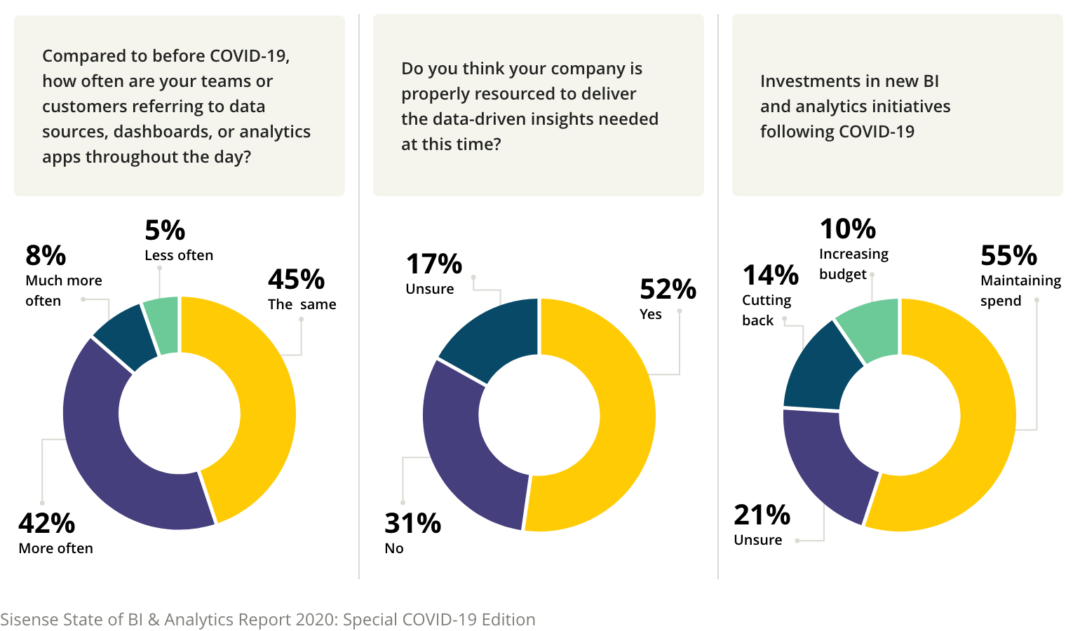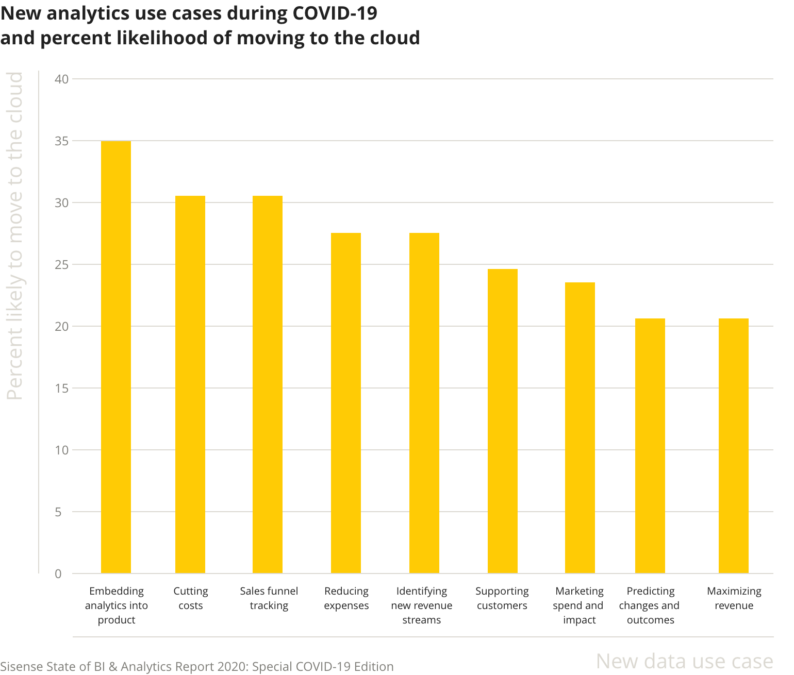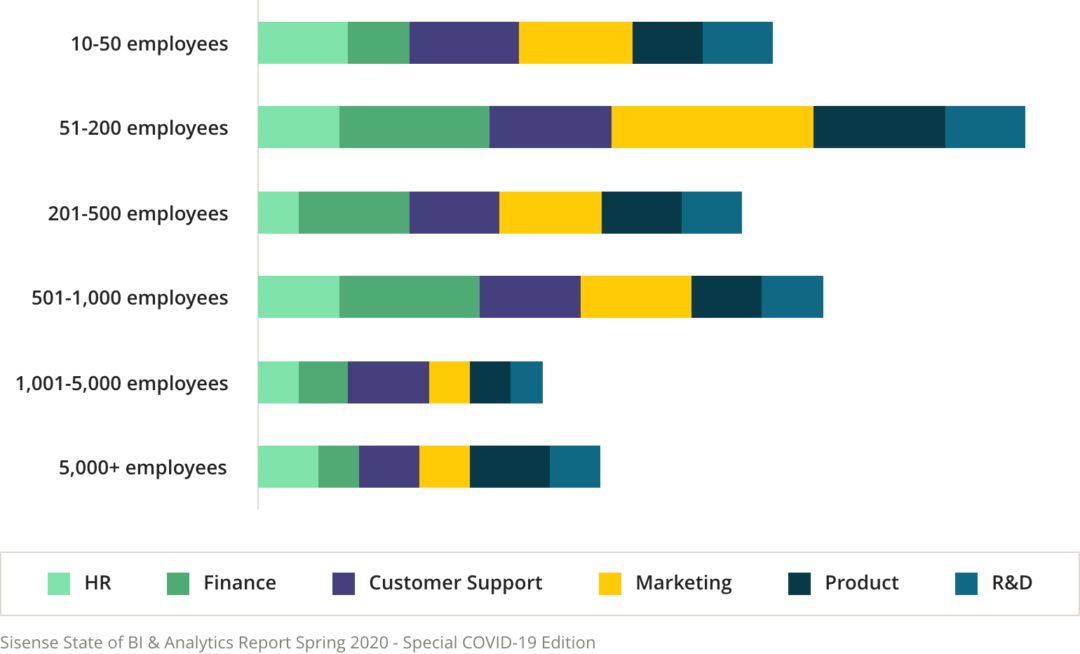Nobody likes uncertainty, but the novel coronavirus situation is a black swan event, its impact unexpected and still largely unpredictable, nearly six months into it. That being the case, perhaps it’s no surprise to see that data analytics is driving value amid this cloudy landscape, as businesses search for order amidst the chaos of the marketplace.
A recent report from Sisense, a business intelligence software company, reveals many fascinating trends and insights into the way that companies are using and expanding their data analytics adoptions and use cases. Perhaps most notably, Sisense’s results reveal that data professionals are a lot more optimistic about the future of business than we might have expected.
Optimism is the order of the day
A significant majority of Sisense’s respondents struck an extremely optimistic note when it comes to the economic health of their own companies. Some 79% believe that they will either stay afloat, or invest and grow. There’s also a strong correlation between optimism and the belief that analytics and business intelligence (BI) will continue to be just as or more important than they were before Covid-19.
It’s a well-known business theory that generally, restrictions breed creativity and open up possibilities for those who are able to see the potential, and Sisense’s data supports this theory. Approximately 46% of respondents say they see new opportunities arising as a result of the coronavirus; 34% are actively growing their data teams; and 28% are currently working on using data to spot and act on new business opportunities.

Companies in healthcare, travel, government, and manufacturing industries are the most focused on seizing the moment to restructure resource use and refine business models.
That said, survey participants were mixed about whether their organisations have the resources needed to support their data analytics programs. While data use is staying stable or going up, only slightly more than half of respondents felt confident they could deliver the data-driven insights they need.
Data analytics use cases are expanding
Companies are adding more data analytics use cases to their daily activities as they race to stay afloat in an increasingly competitive market. The majority of enterprises say that they are mostly using data to improve efficiency, deliver better customer service, and predict changes and outcomes.
How to implement AI and advanced analytics, and observe the technologies’ transformational impact
Faced with a drop in revenue, businesses are using data analytics to search for more cost efficiencies they can make in their organisations. Customer habits and pain points have changed suddenly and dramatically, leaving departments to mine data quickly in order to adjust to their consumers’ new needs. Additionally, the future is uncertain and threatening, so it’s vital for companies to make the most of their data to find the best ways to adapt to whatever may come their way.

The most common use of analytics that companies are exploring today for the first time, according to the report, is embedding analytics into their products.
At the same time as applying data analytics to new use cases, businesses are also exploring their options for replatforming and migrating to the cloud, to optimise their data analytics processes.
Industries show a range of responses to data analytics use
The surge in data analytics adoption is hardly uniform across all industries. The professional services, healthcare, and marketing verticals show the highest rise in data analytics use, but not the highest rise in spending on data analytics tools and platforms.
This could be because these are industries that are more likely to already have robust systems in place to support their expanded use cases.
Retail, government, and media companies are the ones showing the highest increase in investment in data analytics. In the case of government, it’s easy to make the case that there’s been a need to catch up to other industries when it comes to investments in analytics. The public space is known to be laggardly in terms of in-place infrastructure to expand data analytics operations.
On the other hand, retail and media are spaces where data has already saturated the way businesses are run, with the lion’s share of organisations arguably having undergone transformations long before the pandemic.
Small is beautiful
It’s interesting to see that SMBs are leading the charge in data analytics adoption and increased application to new use cases. For the past five-plus years, the pervading narrative in the analytics industry has been that business intelligence was once only accessible to enterprise-level players, while the rise of self-service business intelligence (SSBI) software in the age of software as a service has democratised data, finally making it possible for smaller firms to level the playing field.
Why collaboration is the key to true business intelligence
This report provides strong evidence that BI is truly finally being used by companies of every size. Indeed, businesses with 51 to 200 employees are seeing the biggest increases in data analytics use, across all departments. Here are some interesting use cases for data among this cohort:
- 68% are using analytics in operations
- 56% in finance
- 50% in sales
- 45% in product

On top of that, companies of this size show the biggest adoption increase in marketing, finance, and customer support use cases, which are all departments that are the most directly affected by the pandemic’s business impact.
Large enterprises are struggling to invest in expanded BI activity. They frequently have entrenched data silos and practices that hold them back from innovation. In contrast, smaller enterprises are more agile. They are generally younger organisations, so they benefit from the most up-to-date tools, without any legacy systems that hold back their older competitors. They’re also more likely to have been founded in the age of cloud computing, so migration to off-prem infrastructure is less of a bottleneck.
The future is bright for data analytics
Despite the gloomy outlook for many companies, data analytics doesn’t seem to be in any danger. With the markets experiencing turbulence, the global economy in freefall, and uncertainty on every side, data analytics is needed more than ever. Businesses are discovering the value of their data-driven insights in increasing numbers of use cases, SMBs are stepping up to make the most of their data, and certain industries are noticeably expanding their spending on data analytics.
All the signs point to a time of opportunity for data analytics tools and platforms, and general optimism that data will help companies to survive, and even thrive, through the coronavirus pandemic.






